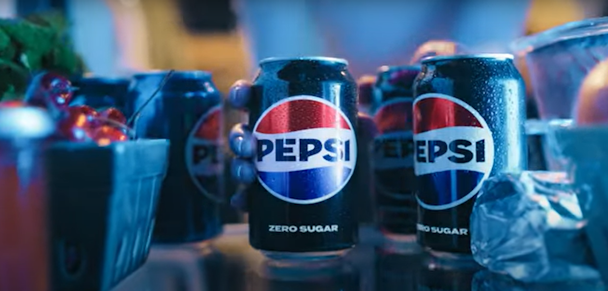‘It’s like our Google’: How PepsiCo is using its AI tool Ada in ad campaigns
How is a mammoth company like PepsiCo actually putting AI to use in campaigns for its Walkers and Pepsi brands?

PepsiCo has begun to use in-house AI strategy tool Ada as a key research element in its marketing / PepsiCo
Back in 2020, PepsiCo unveiled the newest member of its team: Ada. Named after the 19th-century mathematician Ada Lovelace, who was credited with writing the world’s first-ever computer program, the food giant’s centralized digital platform has four main jobs.
One is to explore new product ideas, another is to source, sort and connect millions of consumer insights, the next is to increase collaboratively capabilities among colleagues. Lastly, it is tasked with helping its TV and digital ads become more effective.
Three years on, Ada has informed campaigns for the likes of Walkers and Pepsi. “We think of Ada as our operating platform,” explains Rafik El Noumeir, vice-president of insights and analytics, Africa, Middle East and South Asia sector at PepsiCo. “Specifically on creative development, we have a tool to test creative, whether at the early stage of development ideas all the way to the end. The idea is to keep building on the best ideas until we reach great creative, then fuel that creative so that it has the right impact in the market.”
Advertisement
To begin, the team will use the different modules within the AI platform to test ads. They will often start with quite a conceptual idea and get it in front of people to gauge their reactions, then filter right down to a finished film. In the past, they would have done individual tests with various partner companies but now they can do that in-house which has been a great time-saving exercise for PepsiCo in the long run, too.
Monica Tenorio, PepsiCo’s vice-president of insights, analytics and marketing capabilities in Europe, says that Ada has been pivotal in changing the workflow. According to the marketer, teams weren’t spending enough time thinking about the real brand and creative questions that needed to be addressed or how to implement those recommendations for future campaigns.
She reckons that staffers were spending about 80% of their time making the work and then 20% in the pre and post-phases. Ideally, PepsiCo needed that 80% to look more like 10%, so teams would have more time to think about strategy and apply any findings from the research to future projects. According to Tenorio, Ada is PepsiCo’s equivalent to Google.
Advertisement
Fortunately, each time the company uses the internal platform, it becomes smarter and all the data or insights that creatives, strategists or marketers may need are in one place. This means that when it comes to advertising for its plethora of brands, PepsiCo can go back in and compare, analyze and really see the areas that it needs to improve on more efficiently than using external sources.
“Let me tell you why this is important for PepsiCo. First of all, we invest around $900m in digital and mobile advertising,” explains Tenorio. “That’s a lot of money and we didn’t really know how well the assets that we were putting behind this investment actually were delivering the necessary ROI for us.”
The company’s product portfolio includes around 23 brands, each of which rakes in around $1bn annually. One in particular that needed some assistance and review was crisp-maker Walkers. “We had a very challenging period where we were really starting to lose share with one of the most iconic brands in the UK. We weren’t exactly sure of what was driving that and how we can reignite growth,” admits Tenorio. “There was an opportunity to leverage Ada to do that. I mean, really trying to understand what happened in the last few years.”
Suggested newsletters for you
The intelligence system found topics that resonated with consumers at that moment and found that Walkers no longer registered within the culture of British people. Using these insights, the Frito-Lay brand was able to go back and speak to people in the UK about food culture. What transpired was a correlation between crisps and lunchtime, spawning the ‘Crisp In or Crisp Out’ campaign.
Various iterations of the TV ad were tested on consumers using Ada, which PepsiCo views more as a learning tool than anything else. “We found out how to fine-tune some of those executions to make them even more relevant and impactful,” Tenorio continues, explaining that they have two main areas of focus. One is how the ad will be predictive of sales for the brand and the other is how it will build equity for the future. “We just kept improving the scores for our communication.”
There’s another brand in the portfolio that, in recent years, became a little bit tricky to market. “Pepsi is actually very hard when it comes to creative,” adds El Noumeir. “I would say is one of the most challenging brands from a creative standpoint to keep pushing that edge.”
He refers to a campaign the soda manufacturer released in Egypt that starred Premier League footballer Mo Salah. Through Ada and its ability to home in on specific markets to gather data, Pepsi was able to identify that Egyptian youths were ‘thirsty’ for change and opportunity. The platform was able to consider the nuances of that region and helped narrow down the idea of highlighting Salah and his sporting journey to younger Pepsi consumers.
“The results of that campaign were phenomenal. It created a lot of a lot of buzz, but also hit specific business metrics of gaining share consistently over time,” says El Noumeir. “The campaign isn’t a one-off, over time it's building share and awareness with Egyptians.”
For PepsiCo, the successes come from a mixture of human insight and AI and the faster identification of opportunities. “It’s always a combination,” says Tenorio. “What Ada has done for us is powered the brain from our teams to operate in a faster, more cost-efficient way and with a clear direction that would have taken us a long time to find out if it wasn’t for Ada.”
This article is based on a keynote presentation and The Drum’s interview with Monica Tenorio and Rafik El Noumeir, at the Esomar Conference in Amsterdam in September 2023.

